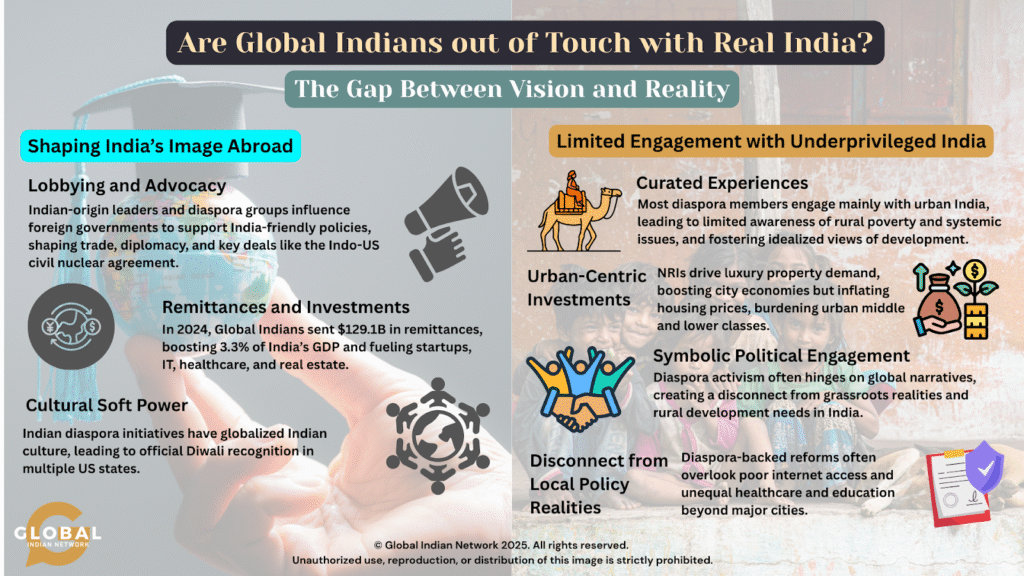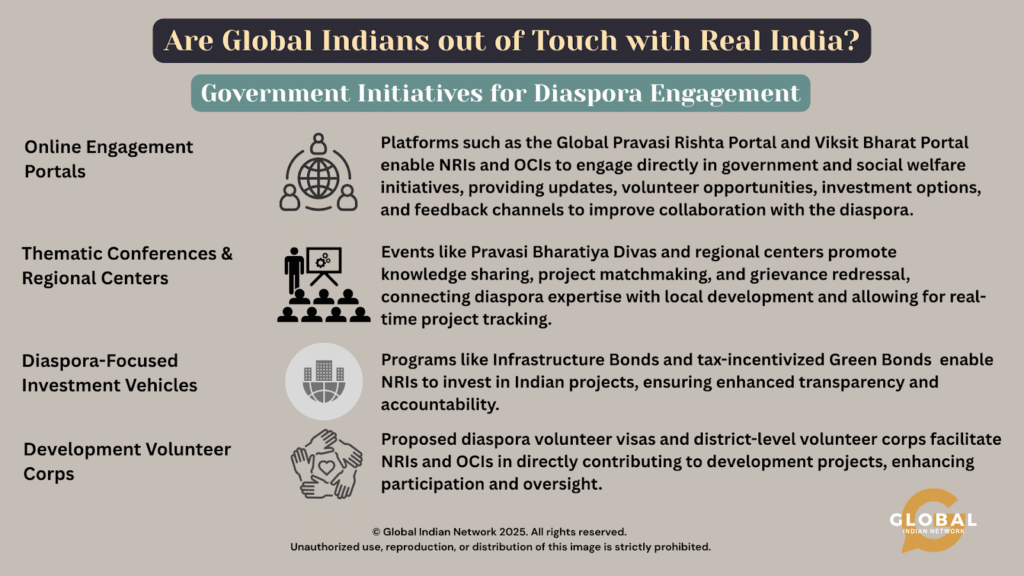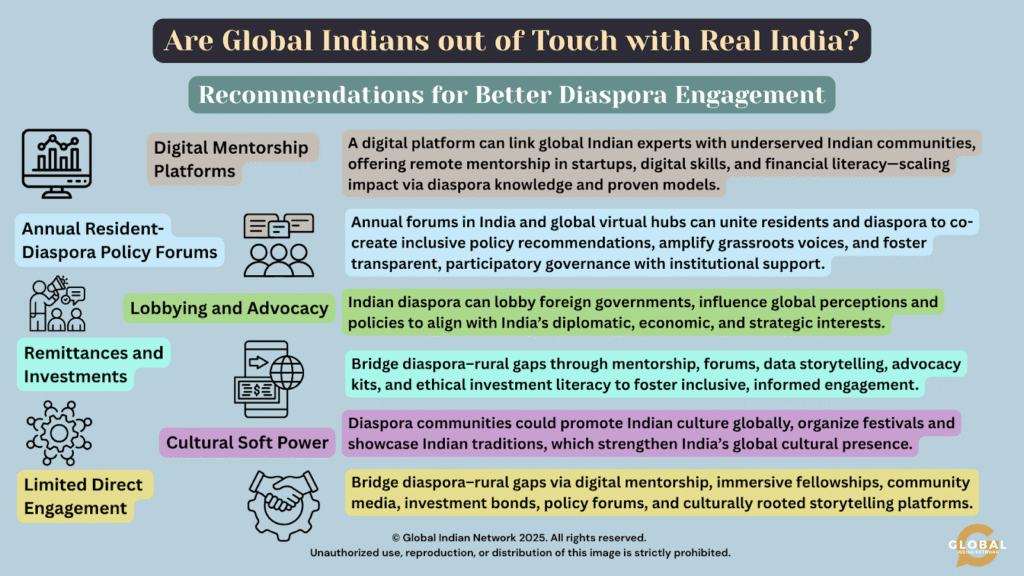The Indian diaspora is one of the largest in the world, comprising over 35 million people spread across continents. From the tech corridors of Silicon Valley to the trading hubs of Dubai and Singapore, Non-Resident Indians (NRIs) have built influential positions in business, politics, and academia. They remain deeply connected to India—sending back remittances worth over $100 billion annually, investing in start-ups, and often acting as cultural ambassadors.
Yet, there is an increasing question within policy circles and social debates: are global Indians out of touch with the realities of everyday India? While their narratives about India shape global perceptions, many observers argue that their distance from the country shields them from the complexities, contradictions, and challenges of life within it.
Let us not go by the hype. We will help you find out.
Table of Contents
Variety within the Indian Diaspora
The Indian diaspora is far from being a homogeneous group; it varies widely by generation, profession, and host country, influencing how members engage with India and maintain their identity.
Generational Differences
First-generation migrants maintain strong emotional ties to India, viewing it as their homeland and engaging in traditional practices. Second-generation individuals blend cultural identities, navigating weaker emotional connections while expressing pride through artistic engagement. Third-generation migrants perceive India as an abstract ancestral homeland, identifying more with their country of birth and primarily interacting with India via globalized cultural expressions.
Professional Diversity
The Indian diaspora includes both high-skilled professionals, like IT experts and entrepreneurs, who contribute to India’s intellectual and technological sectors through investments and collaborations, and low-skilled migrant workers, mainly in the Gulf, who remit money back home. The experiences of these groups differ significantly, with low-skilled workers having limited involvement in policy or cultural issues, whereas high-skilled individuals actively link Indian markets with global opportunities.
Host Country Context
The Indian diaspora in Western countries enjoys stable political rights and strong educational opportunities, engaging actively in various sectors. Conversely, Indian workers in Gulf countries face restrictive conditions affecting personal freedoms and employment rights, leading to an economically driven relationship with India primarily through remittances, creating distinct diasporic dynamics.
Impact of Variations
India’s diaspora engagement strategy must acknowledge the diverse identities, aspirations, and constraints of various diaspora groups. Initiatives effective for the elite, professional diaspora in the West may not be relevant for descendants or labor migrants, highlighting the need for a nuanced approach to foster meaningful connections beyond mere symbolic or economic ties.

Diaspora Narratives: Pride and Idealism
India is viewed by global Indians, especially NRIs, as a rising economic power and a symbol of cultural pride, fostering nostalgia and aspirations. Diaspora academics in Western universities depict India as a modernizing democracy with deep-rooted traditions.
NRIs actively engage in political advocacy, positively influencing India’s global image and lobbying foreign governments for policy support. This advocacy enhances India’s soft power by improving access to international media, financial markets, and think tanks. For example, a second-generation entrepreneur in New Jersey can shape U.S. investor views on India’s digital economy while sidestepping domestic bureaucratic challenges.
Quantitative Insights
Here are some relevant statistics:
- The Indian diaspora is the world’s largest emigrant population, comprising about 15.85 million Non-Resident Indians (NRIs), 19.57 million Persons of Indian Origin (PIOs), and Overseas Citizens of India (OCI).
- Nearly half of this diaspora population resides in just 10 countries, with the United States (approximately 5.4 million), the United Arab Emirates (around 3.6 million), Malaysia (approximately 2.9 million), Canada (2.8 million), and Saudi Arabia (2.4 million) being the top countries of residence.
- India has remained the top global recipient of remittances for over a decade, with remittance inflows reaching a record $135.46 billion in 2024-25, a 14% increase from the previous year, providing a significant economic link between the diaspora and India.
- Despite these numbers, the vast diaspora often experiences India through curated visits and media narratives, lacking direct exposure to the complex realities of rural poverty, infrastructural gaps, and social inequalities that persist among many Indians.
These statistics emphasize the large size and global dispersion of the Indian diaspora, their economic importance through remittances, and the potential disconnect caused by distance and selective exposure to India’s realities.
The Gap Between Vision and Reality
India’s economic growth is juxtaposed with significant inequalities, complicating access to clean air, healthcare, education, and housing. Challenges persist in rural distress, unemployment, and gender disparities, despite a focus on start-ups and unicorns in media narratives. Non-Resident Indians (NRIs) often overlook these contradictions; for example, they may celebrate advanced hospitals like Apollo and AIIMS while neglecting the problems faced by underfunded Primary Health Centres. Additionally, the diaspora recognizes IT successes but fails to address issues of automation and underemployment affecting young workers in Bengaluru.
Global Indians significantly shape India’s image abroad through economic, political, and cultural actions such as lobbying, sending remittances, and promoting Indian traditions. However, the article highlights that most in the diaspora lack direct engagement with rural and underprivileged populations, resulting in a disconnect between their narratives of India and the everyday realities on the ground.
Shaping India’s Image Abroad
Lobbying and Advocacy: Indian-origin politicians, business leaders, and diaspora communities lobby foreign governments to support India-friendly policies, significantly influencing trade and diplomatic relations, including key agreements such as the Indo-US civil nuclear deal, and shaping ties with the UK, US, and Gulf countries.
Remittances and Investments: Global Indians sent a record $129.1 billion in remittances to India in 2024, supporting millions of families and contributing around 3.3% of the nation’s GDP. Diaspora investors have helped fund successful Indian start-ups, bridged markets for Indian enterprises, and contributed to sectors such as IT, healthcare, and real estate.
Cultural Soft Power: The spread of Indian festivals, cuisine, Bollywood, and yoga across the world owes much to diaspora-led initiatives and their role as cultural ambassadors. Efforts by diaspora groups have resulted in celebrations such as Diwali being recognized in several US states.
Limited Engagement with Rural and Underprivileged India

Curated Experiences: Most diaspora members have limited engagement with India, primarily through family visits and city experiences, which leads to a lack of awareness about rural poverty and systemic issues in healthcare and education. This selective exposure can create distorted perceptions and idealized narratives regarding India’s development.
Urban-Centric Investments: NRIs are major buyers in luxury property markets, but this mainly benefits affluent city economies and inflates housing prices, often at the expense of the urban middle and lower classes.
Symbolic Political Engagement: Diaspora activism and campaign contributions often rely on global headlines or partisan rhetoric, leading to a disconnect from actual policy implementation at the grassroots level. Consequently, diaspora initiatives may not effectively address the actual developmental needs in rural India.
Disconnect from Local Policy Realities: Advocacy for progressive reforms or digital India initiatives by diaspora groups may overlook patchy internet access and deep disparities in healthcare and education availability outside major cities.
Political Activism and Global Narratives
Many diaspora organizations influence Indian politics by supporting leaders and policies, often based on media narratives rather than personal experiences. Their endorsement of initiatives like “Digital India” neglects issues like inconsistent rural internet access. Discussions within the diaspora often reflect partisan divides, overlooking valuable insights from those directly affected by policies. Critics argue that this “romanticized activism” misrepresents India internationally, as Non-Resident Indians (NRIs) may hold views that differ from those of average citizens. Furthermore, diaspora lobbying often emphasizes appealing symbols over genuine developmental challenges faced by India.
Diaspora political engagement tends to echo global headlines and align with Western campaign styles, rather than addressing actual grassroots policy effects in India.

The Economic Contributions vs. Emotional Disconnect
Global Indian communities have a significant influence on India’s education, healthcare, and corporate governance through remittances and investments in startups. However, their contributions often overlook local realities. In real estate, the demand for luxury properties by NRIs inflates prices in cities like Bengaluru and Gurugram, negatively impacting middle-class buyers. Additionally, NRIs’ views of India are shaped by curated experiences, which differ significantly from the challenges faced by average Indian families.
Remittances and foreign investments make significant contributions to economic growth, particularly in the private sector and the real estate industry. However, these inflows may not encourage local empathy or awareness, as seen in NRI luxury housing investments that raise prices and widen the affordability gap for urban middle-class residents. While beneficial overall, this trend often overlooks critical issues, such as rural infrastructure deficits, social inequality, and high unemployment rates in India.
Transformative Diaspora Engagement Examples
- Sam Pitroda and India’s Telecom Revolution: A pioneering Indian diaspora technologist, Sam Pitroda, returned to India in the 1980s and played a crucial role in transforming India’s telecommunications sector. His work enabled better connectivity and services to underserved rural areas, demonstrating how diaspora expertise can spearhead inclusive development.
- American India Foundation (AIF): Founded by NRIs in the US, AIF funds education and livelihood projects in India with a focus on primary education and women’s empowerment. These philanthropic initiatives have had sustained developmental impacts by building grassroots capabilities.
- Punjab’s “Mera Pind” Initiative: Sponsored partly by Punjabi diaspora Sikhs, this program encourages development in native villages through infrastructure projects, health camps, and education programs. It shows diaspora contributions directly fueling rural progress.
Examples of Diaspora-Resident Friction
Philanthropy from the diaspora can exacerbate social divides by prioritizing regional, caste, or religious factors over broader community needs, as seen in Punjab, where such funding has heightened communalism and caste-based tensions. Additionally, diaspora projects often struggle with adapting to local contexts, facing resistance due to logistical issues such as understaffed clinics and established local practices. Moreover, the focus on prestigious, visible projects rather than addressing deeper systemic problems limits their long-term effectiveness and can lead to skepticism among local populations.
Diaspora Personal Reflections
Here are authentic, real-life quotes from the Indian diaspora about their engagement and perspectives—spanning cultural connection, economic contribution, and evolving relationships with India.
“India represents a profound connection to my roots and my heritage. As a member of the diaspora, we think that India is a country rich in culture, and at the same time, its economic advancements and technology symbolize a part of who I am and where my ancestors are from.” – Sunisha Singh, Fiji Indian diaspora delegate, Know India Programme.
Policy and Leadership Quotes
“The government, under the leadership of our Prime Minister Narendra Modi ji, has accorded the highest priority to the diaspora engagement, and it is clearly evident in the plethora of diaspora initiatives taken since 2014.” – S. Jaishankar, India’s Minister of External Affairs.
Community-Related Reflections
“The diaspora’s potential isn’t really realised, though. Demands for dual citizenship and an unequal focus that prioritises wealthy non-resident Indians over Gulf labourers draw attention to engagement gaps. … Tourism and the diaspora work in tandem: tourists experience India’s charm firsthand, while the diaspora extends it abroad. … Yet, challenges persist — tourism needs sustainable scaling, and diaspora engagement requires strategic depth.”
Current Government Initiatives for Diaspora Engagement
The government has launched several programs to ensure transparent, accessible, and impactful collaboration with the Indian diaspora:
Online Engagement Portals
Platforms like the Global Pravasi Rishta Portal and Viksit Bharat Portal can facilitate the direct involvement of NRIs and OCIs in government and social welfare projects, offering updates, volunteer opportunities, investment prospects, and feedback mechanisms to enhance diaspora collaboration.
Thematic Conferences & Regional Centers
Events such as Pravasi Bharatiya Divas and regional centers can facilitate knowledge sharing, project matchmaking, and grievance redressal, linking diaspora expertise with local development agendas and enabling real-time project progress tracking.

Diaspora-Focused Investment Vehicles
Programs like Infrastructure Bonds and tax-incentivized Green Bonds could enable NRIs to invest in Indian projects, ensuring enhanced transparency and accountability.
Development Volunteer Corps
Proposed diaspora volunteer visas and district-level volunteer corps facilitate NRIs and OCIs in directly contributing to development projects, enhancing participation and oversight.
Diaspora Fellowships and Reverse Sabbaticals
SBI Youth for India Fellowship: This 13-month fellowship places young professionals with rural NGOs to work on development projects across 12 themes (health, education, livelihoods, women empowerment, renewable energy, etc.). Fellows receive mentorship and a stipend while immersing themselves in local communities.
AIF Banyan Impact Fellowship: Run by the American India Foundation, this fellowship allows diaspora youth to collaborate on developmental projects with NGOs in India. The fellowship focuses on creating sustainable community impact through capacity building, providing a pathway for diaspora members to contribute meaningfully on the ground.

Current NRI-backed Startups Empowering India
Here are examples of inclusive investments by Indian diaspora-backed or startup initiatives focused on renewable energy and affordable education technology targeting rural and underserved Indian populations:
Renewable Energy
Zerowatt Energy: An AI and IoT-driven energy intelligence startup founded in 2020 in Ernakulam, Kerala, helps industrial clients, such as Mahindra Aerospace and Manorama Group, to monitor and reduce energy wastage. It is incubated by IIT Madras and supported by Kerala Startup Mission.
Gunsola Hydro Power Generation: Founded in 1995, this NRI-led hydroelectric power company in Uttarakhand, established by Rajesh Gunsola, focuses on local employment and plans to expand into solar energy projects.
ReNew Energy: ReNew Energy, founded in 2011 by Sumant Sinha, is India’s second-largest renewable energy company, concentrating on wind and solar projects. It operates more than 150 projects across ten states and boasts a global portfolio of 17.4 GW.
Agritech
FarmTheory: A Bengaluru-based agri-food startup, founded in 2019 by Sakshi Agarwal and Arpit Agarwal, ethically sources and delivers fresh fruits and vegetables to the food service and processing industry.
Fragaria: An agritech startup, founded in 2015, is relocating its headquarters from Chennai to Bengaluru due to climate challenges. The company specializes in agricultural technology and operates an R&D farm in Chennai.
DeHaat: DeHaat, founded in 2012 by Shashank Kumar and Shyam Sundar, is an agritech startup in India that offers comprehensive solutions for farmers. Utilizing AI to enhance supply chain and production efficiency, it operates across 12 states with over 11,000 DeHaat Centers and 503 Farmer Producer Organizations (FPOs), benefiting more than 1.8 million farmers.
Fintech
Belong: Founded in 2024, Belong is a fintech startup targeting NRIs by offering a USD fixed deposit product in collaboration with Indian banks at Gift City. The company seeks to alleviate common challenges faced by NRIs, such as complicated KYC processes and significant currency conversion expenses.
Aspora: Aspora, founded in 2022 by Parth Garg and rebranded in April 2025, is a London-based fintech startup serving the global Indian diaspora. It specializes in cross-border financial services, offering zero-fee remittances and competitive exchange rates, having processed over $2 billion in transactions and saved users over $15 million in fees.
NRI Agritech Pvt Ltd: A startup founded in 2008 focuses on making agriculture more profitable by innovating high-yielding hybrid crop varieties using advanced technologies.
Affordable Education Technology
Notable initiatives globally and in India highlight digital mentorship platforms that connect experts with students from underserved communities. Startups are connecting diaspora professionals with rural learners to enhance their skills and foster entrepreneurship.
Recommendations for Better Diaspora Engagement
Digital Mentorship Platforms
A dedicated digital platform can connect global Indian experts in technology, healthcare, business, and education with students and entrepreneurs from underserved regions. Mentors can guide startup growth, digital skill development, financial literacy, and social entrepreneurship remotely. This approach utilizes diaspora knowledge to create scalable impact and fosters sustained connections between experts and local beneficiaries. Existing mentorship models from organizations like TiE Global, AIF, and startup incubators can be integrated or used as templates.

Annual Resident-Diaspora Policy Forums
Annual forums in India and virtual hubs globally will enable residents and the diaspora to exchange policy narratives, collaboratively create recommendations for rural development, education, digital infrastructure, and health, and engage with grassroots leaders. Support from governmental and non-governmental organizations will encourage diverse representation, with forum outcomes published to enhance inclusive policymaking and strengthen diaspora engagement.
Lobbying and Advocacy
Indian diaspora members actively lobby foreign governments to support India’s diplomatic and economic goals, helping shape international perceptions and policies favorable to India.
Remittances and Investments
Global Indians send billions annually in remittances, which support families and fund businesses back home, contributing significantly to India’s economy. However, this financial contribution is often accompanied by a limited understanding of the systemic issues faced by many Indians in rural areas.
Cultural Soft Power
Diaspora communities promote Indian culture globally, organizing festivals and showcasing Indian traditions, which strengthen India’s global cultural presence. Programs such as SBI Youth for India Fellowship and AIF Banyan Impact Fellowship can be expanded or customized to attract NRIs who want a sabbatical experience that combines service with cultural re-connection.
Limited Direct Engagement
Despite their strong presence abroad, many diaspora members experience India mainly through urban, privileged environments and curated visits. This often leads to a gap in understanding the realities of poverty, rural distress, and infrastructural challenges faced by a large part of India’s population.
In summary, the diaspora’s global influence is significant but often lacks a deep connection with India’s grassroots realities, which could limit the authenticity and effectiveness of their advocacy and contributions.
Reconnecting Narratives with Real India
NRIs are encouraged to engage in rural development and grassroots initiatives in India beyond just luxury tourism. They should advocate for investments in affordable healthcare, renewable energy, and skills training while maintaining an honest discourse about India’s realities. Continuous dialogue between NRIs and resident Indians is necessary for effective policy feedback. Additionally, enhancing transparency through digital platforms and grassroots volunteering will amplify the impact of the diaspora. Reforms in property investments, including targeted taxation and affordable housing initiatives, will help mitigate housing price inflation and promote market fairness.
Proposed Reforms in NRI Property Investment
To address housing inflation and ensure fair access for residents, the following reforms are recommended:
Data and Policy Audits
Maintaining a unified, transparent database of NRI property purchases and publishing annual audits would enable the government and the public to monitor market impacts effectively.
Targeted Taxation and Investment Caps
Introducing tiered property taxes, higher stamp duties, and restrictions on luxury and vacant properties may deter speculative investments by non-resident Indians (NRIs), thereby helping to control price inflation and maintain access to affordable housing for residents.
Local Reservation Rules
States could reserve specific affordable housing units for resident buyers or prioritize first-time local purchasers, reducing NRI-driven demand in critical market segments.
Development-Linked Investment Incentives
Tax incentives may be utilized to encourage investments in affordable housing or rural development projects, aiming to channel NRI capital towards benefits for larger communities.

Conclusion
So, are Global Indians out of touch with Real India? The answer lies in degrees rather than absolutes. Their distance—both geographic and experiential—inevitably creates blind spots. Yet, their resources, networks, and love for their ancestral home make them influential stakeholders in India’s journey.
Diaspora lobbying can sometimes distort India’s needs, focusing on symbolic achievements and image-building rather than providing substantive input about real-life policy gaps and failures. The challenge, therefore, is not to dismiss the Indian diaspora but to encourage more grounded, nuanced engagement. How can global Indians channel their influence without becoming detached from the grassroots?
The task ahead is to ensure this influence is grounded in on-the-ground realities. For every success story in Silicon Valley or Singapore boardrooms, there is also a struggle unfolding in an Indian village or city street. Only when both these narratives are woven together can India’s story be fully and authentically told.









